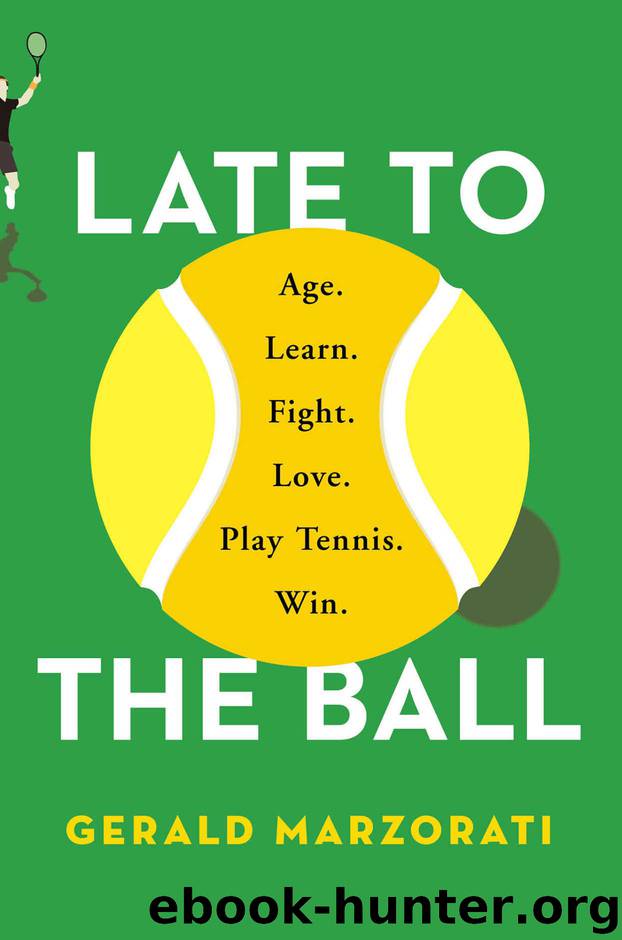Late to the Ball: Age. Learn. Fight. Love. Play Tennis. Win. by Gerald Marzorati

Author:Gerald Marzorati [Marzorati, Gerald]
Language: eng
Format: epub
ISBN: 9781476737393
Amazon: 1476737398
Publisher: Scribner
Published: 2016-05-17T00:00:00+00:00
27
We humans tend to have a strong hand preference. We are alone among the primates, it seems, in being overwhelmingly handed (though monkeys and apes in captivity have been shown to develop handedness). Most of us—somewhere between 75 and 90 percent—are right-handed, and there is no certainty as to why. Somewhere between 10 and 15 percent of us are—like me—left-handed, and we are said to be over-represented in tennis, where our being “other-handed” has an advantage: We are used to righties, their angles and spins; they are not used to lefties. (A few of us—people, not tennis pros—are mixed-handed, doing some tasks with one hand, others with the other. True ambidexterity is rare.)
There is evidence for genetic influence in the determination of handedness; evidence that it is affected (and altered) by cultural and societal norms; evidence that it is connected to prenatal development processes, as the fetal brain develops distinct cerebral hemispheres. As the neurologist Frank R. Wilson suggests in his absorbing book The Hand, our hominid ancestors may have developed their handedness by throwing rocks at what they were hunting, realizing through trial and error that if they kept practicing with one arm and hand, they would throw more accurately. That seems plausible enough, though we cannot really know. Modern neuroscientific research has revealed that for almost all primates, voluntary sequential movements of the arms and hands are, in fact, executed with increasing fluency and precision the more they are repeated. My forehand attests to that, sort of. What I am absolutely certain of is that handedness has at least one drawback. It leaves us with a nondominant hand attached to a nondominant arm. And it’s with this weak, slow, clumsy limb that a serve begins.
Holding a tennis ball out in front of you at thigh or waist height, rotating your shoulder joint in a natural, upward tossing motion, and releasing the ball to send it a few feet above your head would seem the easiest thing you might do on a tennis court. And you are standing still and in complete control, as you are not at any other moment in the unfolding of a tennis point. But when you are sixty, your nondominant arm has been doing a lot of nothing for a very long time. Your muscles are smaller and weaker than they are on your dominant side, your sense of control less. And then there is the whole challenge of quieting yourself, physically and mentally, in the midst of a game spent fiercely on the run. Even top pros can struggle with that.
The proper technique, or one of them—the one Kirill began to impart to me on the Har-Tru indoor court we had been spending our winters on for years—begins with holding the ball gently, like an egg, in a pincerlike grip, at the tips of your thumb and three fingers. Ideally, the ball should leave each of those digits at precisely the same time. What time? When your rising arm reaches the height of your eyes.
Download
This site does not store any files on its server. We only index and link to content provided by other sites. Please contact the content providers to delete copyright contents if any and email us, we'll remove relevant links or contents immediately.
The Compound Effect by Darren Hardy(8733)
Wonder by R.J. Palacio(8383)
Atomic Habits: Tiny Changes, Remarkable Results by James Clear(8122)
Becoming Supernatural by Dr. Joe Dispenza(8038)
Wonder by R. J. Palacio(7867)
Change Your Questions, Change Your Life by Marilee Adams(7564)
The Road Less Traveled by M. Scott Peck(7473)
Born to Run: by Christopher McDougall(7027)
Daring Greatly by Brene Brown(6367)
Big Magic: Creative Living Beyond Fear by Elizabeth Gilbert(5555)
Grit by Angela Duckworth(5447)
The Slight Edge by Jeff Olson(5315)
Men In Love by Nancy Friday(5113)
The Wisdom of Sundays by Oprah Winfrey(5049)
You Are a Badass at Making Money by Jen Sincero(4730)
Fear by Osho(4619)
The Four Tendencies by Gretchen Rubin(4514)
The Miracle Morning by Hal Elrod(4496)
Rising Strong by Brene Brown(4340)
